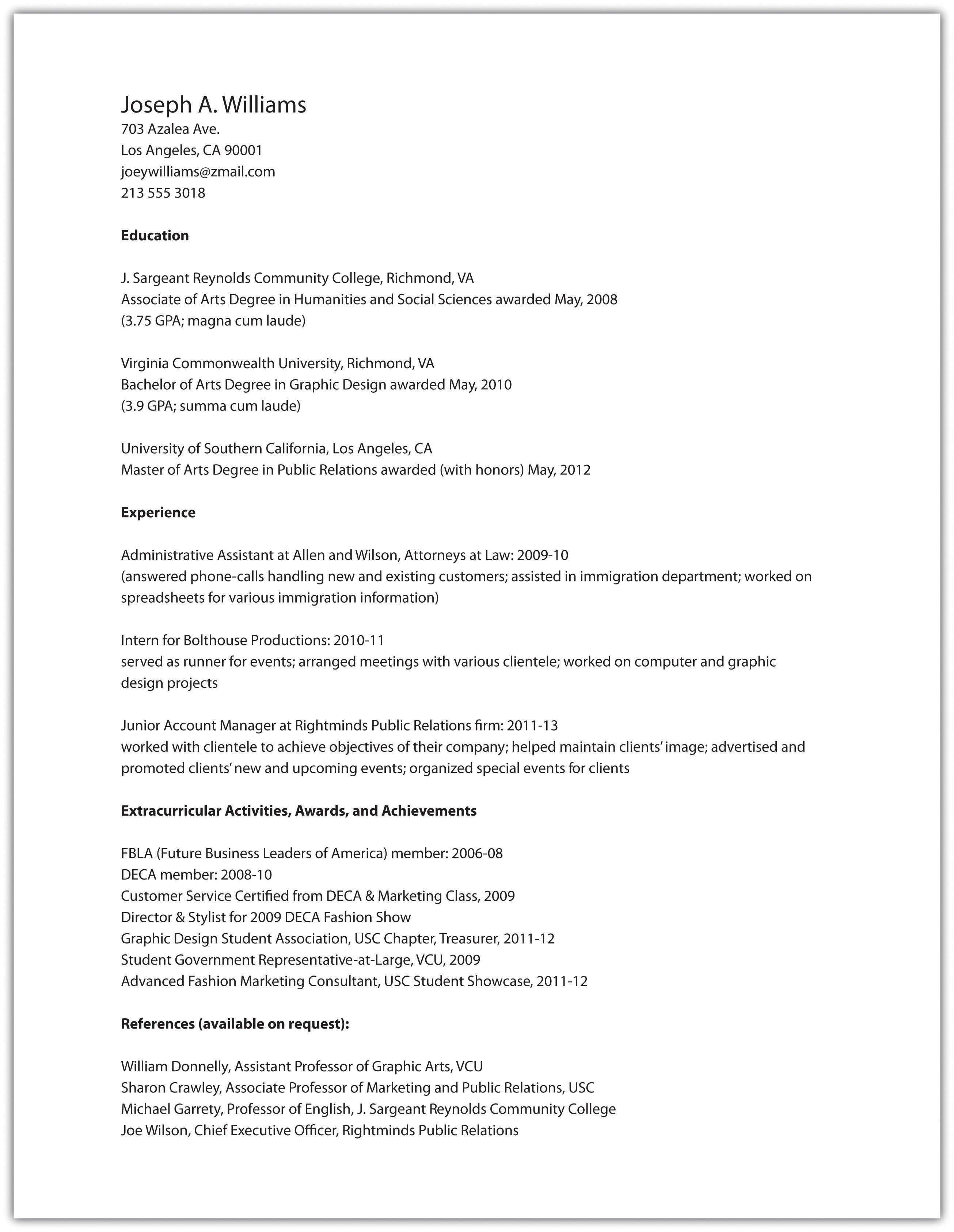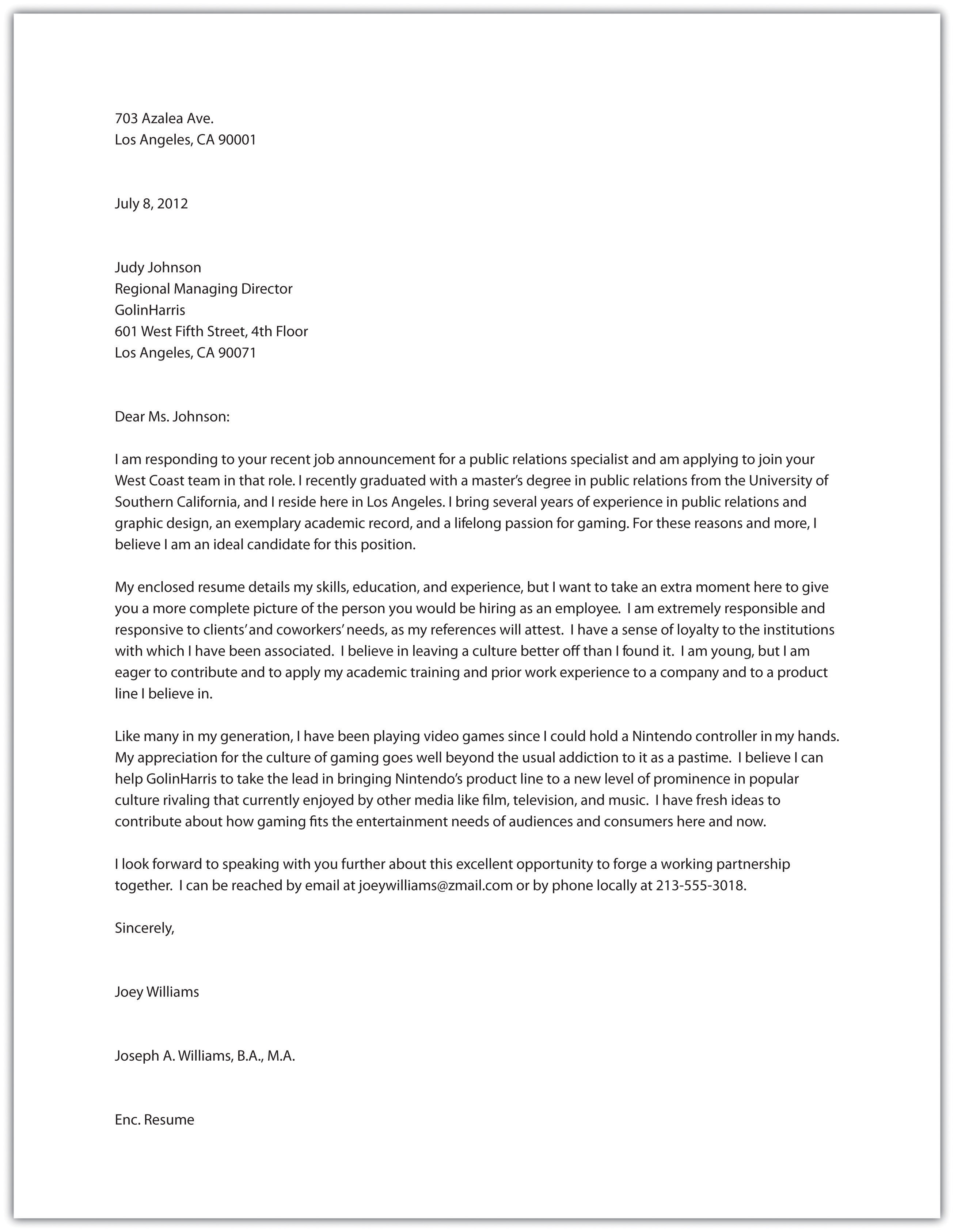As part of the process of applying for any job in any profession beyond the entry level, you are likely to have to produce two main written documents: a résumé and a cover letter or letter of application. Writing these documents well is often a key determiner in whether you get the job. To illustrate, we’ll follow a student, Joey Williams, through these two key professional writing challenges. Joey is a recent graduate of a master’s degree program in public relations who is seeking a position at a graphic design firm.
Common résumé formats vary with types of jobs and with the times, but regardless of the type of position you are seeking, your résumé should include some key features and some key information.
Effective résumés have the following features:
Every résumé should include the following information:
These résumé components are optional:
To ensure that your résumé is both current and appropriate for the position, you should search online for similar sample résumés. You should also run your résumé past the career placement services at your college and any people you know who are working in your field of interest. Here’s Joey’s generic résumé:

Along with sending a résumé when applying for a job, you will almost always want to send a cover letter. This suggestion holds true in both hard-copy and digital situations. A hard-copy cover letter should be formatted as a standard, typed business letter (for a sample, see Chapter 12 "Professional Writing", Section 12.1 "Writing Business Letters"). A digital cover letter should be either typed directly into a given window or copied and pasted into the window. If you copy and paste, check to make sure that the formatting holds.
When the job market is tight, just getting an interview is a major hurdle. Facing dozens and sometimes even hundreds of applicants, employers are looking for reasons to cut down their pool of potential interviewees. Don’t give them a reason not to interview you by writing a vaguely worded, overly general letter of application or résumé, especially when you can easily revise and tailor your approach to each position for which you are applying.
To target a cover letter means to write it specifically for an identified job. You can gather information to target your cover letter by looking carefully at the job description and by studying the company’s website. Let’s look at an example of an online job description that has caught Joey’s attention:
About the Job
GolinHarris is a leading international public relations firm and winner of PRWeek’s Large PR Agency of the Year 2010, 2010 Best Places to Work by the Los Angeles Business Journal, and numerous industry awards.
Our western region headquarters, based in Los Angeles, is currently seeking an ambitious and motivated PR professional to join our team as an Assistant Account Executive. The successful candidate will play an integral role and receive valuable hands-on experience by working on our Nintendo account. We are launching exciting programs in the next few weeks and this opportunity will not last long. Avid gamers are encouraged to apply now.
The candidate we seek will perform fundamental PR tasks such as aiding in production of media-related materials, pitching program highlights to the media, monitoring for quality and quantity of media coverage and managing client publications and resources materials.
What Do You Need to Be Considered?
About Us
As a member of the Interpublic Group (IPG), GolinHarris partners with a network of the communication industry’s best strategists across a variety of disciplines, including sports marketing, consumer research, branding, special events and advertising. We collaborate with these partners to continually advance our clients’ businesses.
At GolinHarris we recognize that there is much more to life than just work. Our benefits program has been designed to help GolinHarris employees and their families stay healthy, balance personal and career priorities, and build a solid and secure future. We offer a great workplace, culture, competitive salary, health care benefits (medical, dental and vision insurance), 401k and more.
GolinHarris is an Equal Opportunity Employer. EEO/AA.M/F/D/V.
Source: GolinHarris
As Joey prepares his cover letter, he’ll need to include, in three or four paragraphs, information about himself and his fitness for the position that complement what his résumé already reveals. Typical contents of the paragraphs of his cover letter might include the following:
Keep in mind that your cover letter is the first chance to present yourself and often the only chance. Besides being sure to include the most pertinent and valuable information you have to offer, be very careful that your letter is grammatically correct with no punctuation or spelling errors. Proofread it carefully yourself, and then, even if you think the letter is perfect, ask a trusted acquaintance to proofread it. Errors in this kind of high-stakes writing situation can be fatal to your chances of achieving your desired goal: getting your foot in the door professionally.
As he is planning his cover letter, Joey decides to apply what he has learned in his academic writing career to this all-important professional challenge. Thus, before writing, he fills out the statement of purpose he used six years before when he was a first-year college student:
| Voice | I am writing as a young, eager, well-educated, and flexible individual who wants to be a part of the GolinHarris team. |
| Message | I want to convey the message that I will bring extensive gaming, graphic design, and public relations experience and credentials to the position. |
| Audience | I want to write to the human resources department or hiring manager at GolinHarris. |
| Attitude | My attitude toward the subject is positive and confident, but also somewhat deferential, humble, and respectful of authority. |
| Reception | I want my audience to give me an interview because they realize they’ve got a hot local prospect who’s perfect for the job. |
| Tone | My tone toward my readers is professional, but creative, enthusiastic, and cutting-edge. |
Armed with his statement of purpose, Joey writes the following cover letter:
